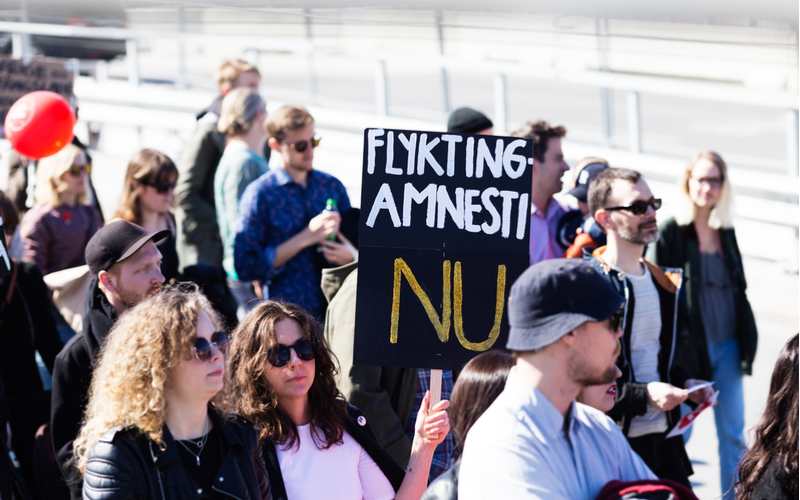The Welfare State Is Politically Incompatible with Diversity
It was once unthinkable. In the country long considered the model of the social-democratic welfare state, along with its egalitarian ethos, the nationalist and populist far right has made huge political gains, all in just a few years. This is despite unrelenting attacks on the “Sweden Democrats” by the mainstream press. Many voters disagreed with what they were supposed to do and instead embraced a form of politics once unknown in this country.
Sweden now joins many other countries in Europe – Italy, Hungary, Poland, France, Germany, and, of course, the UK – in experiencing political upheaval in the wake of the refugee crisis. Sweden took in more refugees than any other country, and now this vote is being widely interpreted as an anti-immigrant backlash.
And that’s about as deep as the analysis goes, along with the now-predictable rhetorical wars over race, nationality, religion, and the politics of hate. If that sounds familiar, it’s because it tracks what is happening in the US today. It’s the breakdown of the postwar political consensus and the move to something new. What that is and means – and whether it is going to mean more or less liberty in our lives – is in flux.
The fundamental political dynamic at play concerns economics and its intersection with culture. To understand, you can do a deep dive into the academic literature on the subject to discover a large literature that goes unreported. Or you can rely on an intuitive grasp of the redistributionist nation state and the demographic and cultural presumptions behind it. Either way, there is a deeper path to understanding what is really happening in Sweden, Europe, and the US today.
Fractionalization
Consider most recently a massive study published by Klaus Gründler and Sebastian Köllner of the economics department of the University of Würzburg, and published by the Munich Society for the Promotion of Economic Research: “Culture, Diversity, and the Welfare State.” It’s a 50-page global study using every bit of data available and every statistical technique for assessing cause and effect, featuring a blithering array of data and references.
At issue is the relationship between population heterogeneity and the stability of the high-tax social-assistance state of the sort built in every European country after the end of the Second World War.
The results are startling if deeply buried:
“In countries that are shaped by a low level of diversity, an increase in religious, cultural, and ethnic variety results in a lower tendency to support redistributive policies. In this case, ethnic minorities may be perceived as posing a political or economic threat to the cultural majority in the country….. [O]ur results demonstrate that an increase in diversity yields a significantly negative effect on the generosity of the welfare state that is most pronounced with regard to cultural and ethnic fractionalization.”
To translate these findings: people will tolerate large, invasive, redistributionist states so long as they think people more or less like themselves are benefiting; that is, provided that the public sector is perceived as an overlord of a large family.
However, when conditions change, and the population loses its collective demographic characteristics, people don’t like their tax dollars funneled to people too much unlike themselves. They will fight that one of two ways: dismantling the welfare state or kicking out those perceived to be interlopers.
In short, all data indicate that the mix of the two – high diversity and high welfare – is not politically sustainable. Again, this is not my opinion much less my wish; it is what all the available literature indicate. This is a gigantic if largely unmentioned problem for social democratic ideology, perhaps its largest single failing.
It goes a long way toward explaining the politics of Europe today. What’s being described as a shift to the “right,” in other words, might be best understood as an attempt to restore not only the unitary state and its traditional demographic of native beneficiaries but also to sustain redistributionist policies against popular resentment. The political expression of that tendency usually trends toxic for a reason: it is only realized by rallying people based on identity politics against some groups who are considered the enemy. And this is what introduces a different brand of collective consciousness, one more nationalist than equalitarian but less liberal than both.
The authors of the above study introduce one proviso they detect in the data, what they call a “tipping point” at which the diversity becomes so high and entrenched that the new immigrants have enough voting power to impose more redistribution by force. The authors treat this as something of a bright spot in otherwise alarming findings. I’m seriously doubtful that most people would share that outlook. It is precisely this apocalyptic political fear that drives the immigration debate in the US.
Support for Welfare
Continuing on with the literature roundup, in 2007, Steffen Mau of University of Bremen wanted to discover whether heterogeneous populations undermine the welfare state’s legitimacy. The result was a literature roundup and 16-nation study called “Sustainable Welfare and Sustainable Growth.”
Speaking from the perspective that welfare states are essential, he wrote that, “The nation state became one of the most important organizational entities for social solidarity…because it provided the fundamentals of a political identity and social morals, which legitimately guaranteed the establishment of social security and transfer systems.”
According to this way of thinking, the whole point of the nation state is to build up a huge transfer system, without which a nation drifts aimlessly. Such a system presumes a level of homogeneity in the population. The ethos is built to exclude outsiders, in other words.
The worry, says Mau, is that, “it is possible that conflicts between the Ingroup and the Outgroup may escalate which could then influence the overall support for the welfare state.” He is very disturbed to find that the more mixed the population, the less you find his sought-after solidarity to support welfare. This is true with regard to immigration in particular: “…welfare spending rates in countries with higher immigration grow significantly smaller than in countries limiting immigration.”
More generally, he finds that the more mixed the population, the more the welfare state comes under popular pressure and its legitimacy is widely doubted. Essentially, if people don’t feel a collective solidarity with fellow citizens, they won’t want their money supporting a collective that includes people with whom they do not share commonality. The less the nation looks and feels like a “family,” in other words, the less people are willing for it to function like a household with the state as both father and mother.
It’s Not Just Welfare
The implications go beyond the welfare state, touching upon all government spending. Dan Hopkins at Georgetown University, for example, notes that between 1970 and 2000, cities with increasingly diverse demographics, “saw significant declines in city spending on various public goods, including roads, health and sanitation.” In this view, diversity even threatens core state functions, tempting people to go it alone. The state-as-family will yield to actual families and other diverse, voluntary, and localized support networks.
Keith G. Banting of Queen’s University (“The Multicultural Welfare State”) says that collectivism can be saved from counterpressure from mixed populations with enough public propaganda. Still he observes that “the durability of a common social model” remains “problematic in several multi-nation countries. Wearying of the struggle between conflicting internal nationalisms, these countries may surrender a common definition of social rights, and devolve the definition of citizen-state relations onto constituent units without the integrative framework and inter-communal transfers essential to preserving equal benefits for all citizens.”
Making this thesis most famous, and presenting the most dire prediction, has been Harvard University’s Robert Putnam. He made a splash a decade ago (while dreading to release his research) for arguing that, “The effect of diversity is worse than had been imagined. And it’s not just that we don’t trust people who are not like us. In diverse communities, we don’t trust people who do look like us.” The Economist sums up his research “Diversity or the Welfare State: Choose One.”
What It Means
The less that “community solidarity” is obvious in demographics, the less people are willing to support political institutions that take from some and give to others. The implications of this research are uncomfortable for all sides. It means that that states that erect large scale interventionist states while declining to control demographics in ways that sustain national feelings are like loaded springs, ready to erupt in revolt. The revolt can turn very ugly because it is deeply personal and cannot resist tapping into identity politics of religious, race, genealogy, and language.
You can render the implications however you like. Most commentators on this phenomenon blame racism for the political destabilization that comes in light of mass immigration. Actually, the research doesn’t support that: the unwillingness of diverse populations to celebrate large-scale transfer states pertains across all groups. Trying to mix two public priorities of demographic diversity together with large welfare provision and regulatory control is going to create political pressures to throw out one priority or the other.
The Liberal Alternative
That is precisely what is leading to the upheaval in Sweden today and many other countries around the world. However, there is a danger in the transition no matter which way you go. From the left, it can give rise to the tendencies we’ve seen in American politics to support migration restrictions as a way of shoring up the numbers of people who can be counted on to political support for welfare, or, more perversely, push toward that “tipping point” of inviting more people in whom can be reliably counted upon to vote for more redistribution and state control. On the right, this dynamic can result in a nationalistic ethos built on intolerance, nativism, protectionism, border controls, police-state tactics, and the rise of strong-man politics.
The much-heralded “postwar consensus” created this problem, out of misguided dreams of a caretaker state that managed the whole of life for everyone in who manages to fit within its inflated geographic orbit. The dream was too big, too expansive, too expensive, and it used the wrong means (force over choice). Something has to give – and this explains the politics over much of the Western world today (and not only the West; China is dealing with the same).
In addition, we are just discovering the full tragedy (or evil) of the welfare/regulatory state: contrary to all stated goals, it preps a society to adopt a nativist, exclusionist, and even racialist political culture.
Whichever way you turn in this complex matrix, you discover dangers to the liberty to move, trade, associate, and keep what is yours. The real lesson of all this data and experience, and the headlines of political upheaval all over Europe, is to illustrate the wisdom and beauty of the liberal vision of small non-invasive, non-redistributionist states, together with free trade, free migration, free enterprise, and cultural tolerance.
Classical liberalism provides a stable mix. It works. These days, neither the left nor right is willing to consider it. In the long run, it’s the only way out of this mess we’ve created for ourselves.











